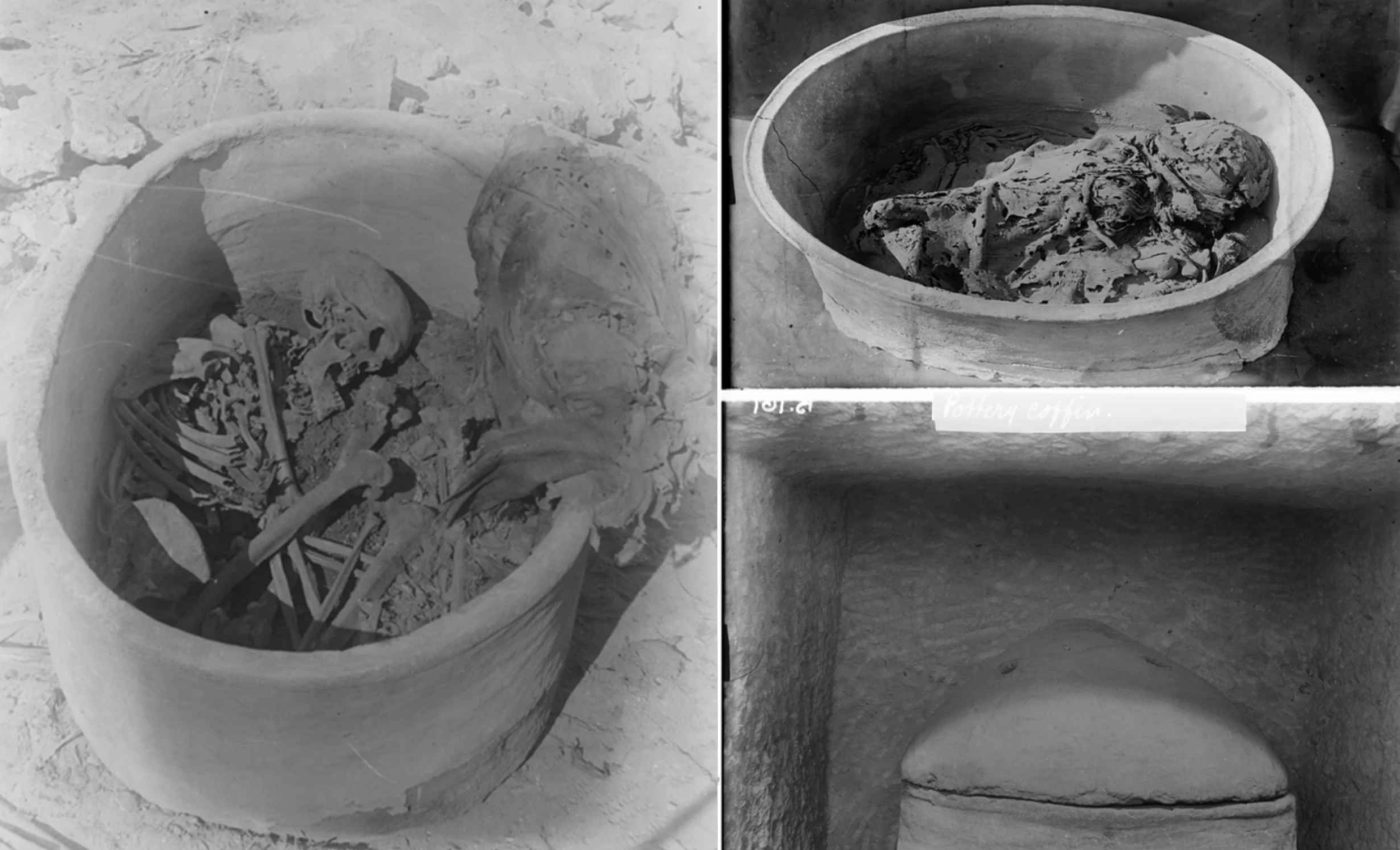
DNA extracted from an ancient skeleton in a pot is a genetic mixture of two distinct worlds
For the first time, scientists have sequenced a complete genome from ancient Egypt. They read the DNA from a man who lived when the earliest pyramids rose along the Nile. The study reports that his ancestry was mostly local to North Africa, with a notable fraction tracing to the Fertile Crescent, a finding that turns a long-suspected cultural link into biological evidence.
Pulling off this kind of work in Egypt has been tough because heat and time shred ancient DNA. In 1985, Svante Pääbo reported the first cloned DNA from an Egyptian mummy, but full human genomes from such old remains remained out of reach for decades.
What makes this ancient DNA special
The man’s remains came from Nuwayrat near Beni Hasan, about 170 miles (275 kilometers) south of Cairo, and his life overlapped the Old Kingdom. Adeline Morez Jacobs of Liverpool John Moores University (LJMU) and the Francis Crick Institute (FCI) led the genetic work and analysis.
“Piecing together all the clues from this individual’s DNA, bones and teeth has allowed us to build a comprehensive picture,” said Jacobs.
Radiocarbon dating places him between 2855 and 2570 BCE. The Egyptian genome was sequenced at roughly twofold coverage from DNA extracted in clean labs from two teeth.
A pot, a tomb, and ancient DNA preservation
His bones were sealed inside a large ceramic vessel set within a tomb of rock. That simple container, and the cool microclimate of the chamber, likely protected the fragile ancient DNA better than open sand or later embalming practices.
“Building on this past research, new and powerful genetic techniques have allowed us to cross these technical boundaries and rule out contaminating DNA, providing the first genetic evidence for potential movements of people in Egypt at this time,” said Pontus Skoglund, senior author at the Francis Crick Institute (FCI).
The team also reports low contamination estimates and the characteristic molecular damage patterns that authenticate ancient molecules.
Age at death was about 60, and estimated height was around 5 feet 3 inches (1.6 meters). Osteoarthritis and other skeletal wear match a life of hard, repetitive work.
The ancient DNA reveals ancestry
The genome indicates about 80% of his ancestry matched ancient North African sources. Roughly 20% aligned with Mesopotamia, a region of the eastern Fertile Crescent.
That split supports a scenario of people moving into Egypt and mixing with locals during the rise of early dynastic states. The genetic signal aligns with evidence for contact across West Asia during this period, including shared technologies and motifs noted by archaeologists.
How scientists read the clues
Tooth roots are rich in cementum, a tissue that often holds better preserved DNA than bone. By targeting that layer and using modern single-stranded library methods, the team pushed past the usual roadblocks for ancient DNA remains from hot climates.
They also paired the genetics with isotope analysis, which reads chemical signatures in teeth to infer diet and childhood geography. Results match a Nile Valley upbringing, consistent with local birth and the ancestry picture reported in the genome.
Rethinking Egypt’s connections
Earlier research retrieved only partial nuclear data from mummies at Abusir el Meleq, and those individuals lived much later than this man from the Old Kingdom era. The new genome fills a gap at the dawn of pharaonic Egypt, when writing systems, monumental building, and complex administration took clearer form.
It also refines the timeline for population links between Egypt and West Asia that had previously been inferred mainly from artifacts. Genetic evidence now shows that some people moved, not just ideas and goods.
Work, status, and a puzzle
“Though circumstantial, these clues point towards pottery, including use of a pottery wheel,” said Joel Irish, second author and bioarchaeologist at Liverpool John Moores University (LJMU). Skeletal stress markers suggest hours spent sitting with extended limbs and repeated upper arm movements.
His interment in a rock-cut tomb and placement in a large ceramic pot indicate relatively high status for the time. That clashes with the physical strain visible in his skeleton, hinting at skill-based prestige or a social story we cannot fully reconstruct from bones alone.
A careful read on a single life
One Egyptian genome cannot stand in for a whole country or centuries of history. The authors note that many more sequences from different regions and time slices are needed to chart how ancestry varied across Egypt.
Still, high quality ancient DNA from this early period provides a touchstone for future work. It anchors models of later population change and offers a baseline for comparing additional individuals when they become available.
Why preservation details matter
Egypt’s climate accelerates DNA decay, so every successful case teaches methods that might work again. Teeth, sealed containers, and tomb microclimates become practical clues for recovery strategies in museums and storerooms.
The lack of mummification in this burial may have preserved DNA that later embalming chemicals would have damaged. That detail will guide sampling choices as teams seek permissions and plan minimally destructive analyses.
The wider picture for human history
Genetic links between North Africa and West Asia mirror known networks of exchange. Writing systems, domesticated plants and animals, and craft techniques moved along these corridors, and now we see that people did too.
As more samples appear, scientists will test whether this Mesopotamian-linked ancestry was common or rare in early Egypt. Whatever the answer, this man’s genome shows that ideas were not the only travelers.
The study is published in Nature.
—–
Like what you read? Subscribe to our newsletter for engaging articles, exclusive content, and the latest updates.
Check us out on EarthSnap, a free app brought to you by Eric Ralls and Earth.com.
—–













